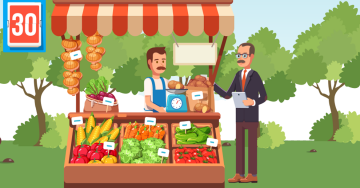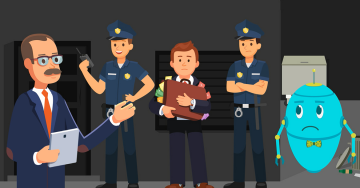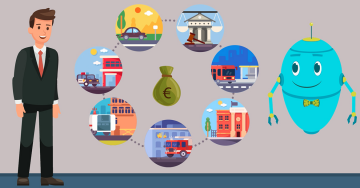
Purpose:
The activity aims at helping students understand the concepts of tax and taxation.
Objectives:
The lesson is an autonomous on-line learning material. It is structured as follows:
• The main characteristics of taxes
• Taxes are a common contribution
• Financing the Common Good
• What sets taxes apart?
• A basic definition for taxes
• Conclusion
The lesson can either be used as a whole, or teachers can use specific sections from the lesson, as they see fit. The average time for attending the entire lesson and the proposed complementary didactic activities is estimated at 30 minutes.
The content of this training course:
- is of general nature only and is not intended to address the specific circumstances of any particular individual or entity;
- does not provide professional or legal advice;
- is valid as of the date of its publication. Updated VAT rates can be consulted on EUROPA.
Only European Union legislation published in the Official Journal of the European Union is deemed authentic.
Materials:
• Micro-clip “What is tax?”
• Interactive whiteboard (or just an LCD projector)
Vocabulary:
tax, taxation

Purpose:
Students should understand the benefits of paying taxes. They should find out examples of early taxes in European history.
Objectives:
- Identify early examples of taxes in European history and funny taxes over time.
- Explain who’s in charge of all the tax money.
- Spot who and how someone benefits from paying taxes.
The content of this training course:
- is of general nature only and is not intended to address the specific circumstances of any particular individual or entity;
- does not provide professional or legal advice;
- is valid as of the date of its publication. Updated VAT rates can be consulted on EUROPA.
Only European Union legislation published in the Official Journal of the European Union is deemed authentic.
Materials:
• Micro-clip “How did taxes come about?”
• Interactive whiteboard (or just an LCD projector)
Vocabulary:
taxes, benefits, public services, national services

Purpose:
Students should understand who has the responsibility of paying taxes nowadays and which are the main categories of taxpayers.
Objectives:
- Identify the necessity of paying taxes and their impact on the community’s well-being.
- Identify the 2 main categories of taxpayers.
- Explain the benefits and responsibilities that someone has from childhood to maturity, when it comes to taxes.
- Debate what kinds of taxes each category should pay for their activities.
The content of this training course:
- is of general nature only and is not intended to address the specific circumstances of any particular individual or entity;
- does not provide professional or legal advice;
- is valid as of the date of its publication. Updated VAT rates can be consulted on EUROPA.
Only European Union legislation published in the Official Journal of the European Union is deemed authentic.
Materials:
• Micro-clip “Who pays taxes nowadays?”
• Interactive whiteboard (or just an LCD projector)
Vocabulary:
taxes, taxpayers, community, income, social contributions

Purpose:
Students should understand the role of the tax authorities in each Member State and how tax revenue is converted into invaluable investments and public services at the local and national level, ensuring a better quality of life for everybody.
Objectives:
This is an autonomous on-line learning lesson. It is structured as follows:
- Presentation of the general taxation system
- Local taxes and the local budget: examples and general use of local tax funds
- The national budget: the role and types of investments supported by the national budget
- Conclusion
Teachers can use this lesson in its entirety or select specific parts, as they see fit. The estimated time for attending the entire lesson and the proposed complementary activities is 30 minutes.
The content of this training course:
- is of general nature only and is not intended to address the specific circumstances of any particular individual or entity;
- does not provide professional or legal advice;
- is valid as of the date of its publication. Updated VAT rates can be consulted on EUROPA.
Only European Union legislation published in the Official Journal of the European Union is deemed authentic.
Materials:
• Micro-clip “Who collects taxes and why?”
• Interactive whiteboard (or just an LCD projector)
Vocabulary:
taxes, taxation system , local taxes, local budget, national budget, public services, investments

Purpose:
Students should understand ways in which taxes help improve the lives of children and those who care for them.
Objectives:
This is an autonomous on-line learning lesson. It is structured as follows:
- The direct impact taxes have on children’s lives
- How taxes help children
- Money collected from taxes benefit everyone
- The consequences of not paying taxes
- Tax evasion
- Imagine a tax-less world
- Conclusion
Teachers can use this lesson in its entirety or select specific parts, as they see fit. The estimated time for attending the entire lesson and the proposed complementary activities is 30 minutes.
The content of this training course:
- is of general nature only and is not intended to address the specific circumstances of any particular individual or entity;
- does not provide professional or legal advice;
- is valid as of the date of its publication. Updated VAT rates can be consulted on EUROPA.
Only European Union legislation published in the Official Journal of the European Union is deemed authentic.
Materials:
• Micro-clip “Do I benefit from taxes? How?”
• Interactive whiteboard (or just an LCD projector)
Vocabulary:
taxes, tax evasion, taxpayers

Purpose:
Students should understand what are the disadvantages and consequences of not paying taxes.
Objectives:
- Identify and understand the concept of “Shadow Economy”
- Explain what counterfeit goods represent and why they damage the Economy.
- Explain why evading tax can bring unwanted consequences not only to the persons evading taxes, but also to the people involved in their activities.
- Debate how people can help prevent tax evasion.
The content of this training course:
- is of general nature only and is not intended to address the specific circumstances of any particular individual or entity;
- does not provide professional or legal advice;
- is valid as of the date of its publication. Updated VAT rates can be consulted on EUROPA.
Only European Union legislation published in the Official Journal of the European Union is deemed authentic.
Materials:
• Micro-clip “What happens if you don’t pay your taxes?”
• Interactive whiteboard (or just a LCD projector)
Vocabulary:
taxes, shadow economy, tax evasion, earnings

Purpose:
Students should understand the main types of taxes in force in the European Union.
Objectives:
- Identify and understand the main types of taxes in force in Member States.
- Understand the differences between direct and indirect taxes.
- Explain the need for taxing individuals’ and companies’ activities.
- Identify in which category each of the presented examples fits best.
The content of this training course:
- is of general nature only and is not intended to address the specific circumstances of any particular individual or entity;
- does not provide professional or legal advice;
- is valid as of the date of its publication. Updated VAT rates can be consulted on EUROPA.
Only European Union legislation published in the Official Journal of the European Union is deemed authentic.
Materials:
• Micro-clip “What kinds of taxes are there?”
• Interactive whiteboard (or just an LCD projector)
Vocabulary:
taxes, direct and indirect taxes, corporate taxes, excise duty, VAT

Purpose:
Students should understand why a business has to pay taxes and how this contributes to the Society’s wellbeing.
Objectives:
- Identify and understand where do the money paid by businesses in taxes go and what happens to that money from that point forward.
- Understand the benefits the employees get due to the taxes paid by their employers.
The content of this training course:
- is of general nature only and is not intended to address the specific circumstances of any particular individual or entity;
- does not provide professional or legal advice;
- is valid as of the date of its publication. Updated VAT rates can be consulted on EUROPA.
Only European Union legislation published in the Official Journal of the European Union is deemed authentic.
Materials:
• Micro-clip “Do businesses pay tax?”
• Interactive whiteboard (or just an LCD projector)
Vocabulary:
taxes, business, State Budget, public services

Purpose:
Students should understand the concept of income and how the taxation applies in this case.
Objectives:
- Identify and understand income taxation for both individuals and companies.
- Understand the benefits that come from paying income taxes.
The content of this training course:
- is of general nature only and is not intended to address the specific circumstances of any particular individual or entity;
- does not provide professional or legal advice;
- is valid as of the date of its publication. Updated VAT rates can be consulted on EUROPA.
Only European Union legislation published in the Official Journal of the European Union is deemed authentic.
Materials:
• Micro-clip “What is income and how is it taxed?”
• Interactive whiteboard (or just an LCD projector)
Vocabulary:
taxes, income, revenue, social system, common needs

Purpose:
Students should understand what environmental taxes are and how they support the protection of the environment.
Objectives:
- Identify the actions that produce damage to the environment and how they can be prevented.
- Explain what environmental taxes are.
- Identify the types of environmental taxes.
The content of this training course:
- is of general nature only and is not intended to address the specific circumstances of any particular individual or entity;
- does not provide professional or legal advice;
- is valid as of the date of its publication. Updated VAT rates can be consulted on EUROPA.
Only European Union legislation published in the Official Journal of the European Union is deemed authentic.
Materials:
• Micro-clip “Can tax help protect the environment?”
• Interactive whiteboard (or just an LCD projector)
Vocabulary:
taxes, environment, pollution

Purpose:
Students should understand what Value Added Tax represents and how is it paid and collected in the EU.
Objectives:
- Understand the general concept of “Added-Value” of a product/service.
- Identify the process of receiving and paying VAT, until it reaches the final destination: the State Budget.
- Identify the EU’s role in collecting taxes and how the EU Budget is funded.
The content of this training course:
- is of general nature only and is not intended to address the specific circumstances of any particular individual or entity;
- does not provide professional or legal advice;
- is valid as of the date of its publication. Updated VAT rates can be consulted on EUROPA.
Only European Union legislation published in the Official Journal of the European Union is deemed authentic.
Materials:
• Micro-clip “Value added tax - VAT”
• Interactive whiteboard (or just an LCD projector)
Vocabulary:
taxes, added-value, State Budget

Purpose:
Students find out the history of customs duties and what is their role in nowadays’ society.
Objectives:
- Find out the origins of customs duties in history and why they had to be paid.
- Understand the role that customs duties play nowadays in our Society.
- Identify how customs duties are applied in the EU.
The content of this training course:
- is of general nature only and is not intended to address the specific circumstances of any particular individual or entity;
- does not provide professional or legal advice;
- is valid as of the date of its publication. Updated VAT rates can be consulted on EUROPA.
Only European Union legislation published in the Official Journal of the European Union is deemed authentic.
Materials:
• Micro-clip “What is customs duty?”
• Interactive whiteboard (or just an LCD projector)
Vocabulary:
Customs duties, duty-free, customs union
